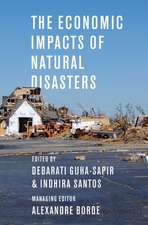Natural and Anthropogenic Disasters: Vulnerability, Preparedness and Mitigation
Editat de M.K. JHAen Limba Engleză Paperback – 23 aug 2016
Disaster management being highly multidisciplinary in nature, a comprehensive book dealing with different aspects of disaster management, and encompassing important disasters faced by humankind is presently not available. This book is an attempt to fulfill this gap. It provides clear, comprehensive, and up-to-date information about different facets of disaster management along with salient case studies. The book highlights the current status of disaster management focusing on developing nations, discusses vital issues such as climate change and sustainable development, modern approaches and tools/techniques, and the challenges of and future R&D needs for sustainable disaster management.
| Toate formatele și edițiile | Preț | Express |
|---|---|---|
| Paperback (1) | 1226.60 lei 43-57 zile | |
| SPRINGER NETHERLANDS – 23 aug 2016 | 1226.60 lei 43-57 zile | |
| Hardback (1) | 1251.19 lei 22-36 zile | |
| SPRINGER NETHERLANDS – 11 dec 2009 | 1251.19 lei 22-36 zile |
Preț: 1226.60 lei
Preț vechi: 1495.85 lei
-18% Nou
Puncte Express: 1840
Preț estimativ în valută:
234.70€ • 245.71$ • 194.21£
234.70€ • 245.71$ • 194.21£
Carte tipărită la comandă
Livrare economică 07-21 aprilie
Preluare comenzi: 021 569.72.76
Specificații
ISBN-13: 9789401777643
ISBN-10: 9401777640
Pagini: 615
Ilustrații: XVI, 615 p.
Dimensiuni: 140 x 210 mm
Greutate: 0.7 kg
Ediția:Softcover reprint of the original 1st ed. 2010
Editura: SPRINGER NETHERLANDS
Colecția Springer
Locul publicării:Dordrecht, Netherlands
ISBN-10: 9401777640
Pagini: 615
Ilustrații: XVI, 615 p.
Dimensiuni: 140 x 210 mm
Greutate: 0.7 kg
Ediția:Softcover reprint of the original 1st ed. 2010
Editura: SPRINGER NETHERLANDS
Colecția Springer
Locul publicării:Dordrecht, Netherlands
Cuprins
Natural and Anthropogenic Disasters: An Overview.- Earthquakes in India: Hazards, Genesis and Mitigation Measures.- Impact of 2004 Tsunami on Housing, Sanitation, Water Supply and Wastes Management: The Case of Ampara District in Sri Lanka.- Impact of December 2004 Tsunamion Indian Coasts and Mitigation Measures.- Tsunami Impacts and Rehabilitation of Groundwater Supply: Lessons Learned from Eastern Sri Lanka.- Tsunami Early Warning System: An Indian Ocean Perspective.- Flood Hazards in India and Management Strategies.- Modeling for Flood Control and Management.- Real-Time Flood Forecasting by a Hydrometric Data-Based Technique.- Drought Hazards and Mitigation Measures.- Indicators for Assessing Drought Hazard in Arid Regions of India.- Tropical Cyclones: Trends, Forecasting and Mitigation.- Temperature Extremes over India and their Relationship with El Niño-Southern Oscillation.- Monitoring Physiographic Rainfall Variation for Sustainable Management of Water Bodies in India.- Emerging Tools and Techniques for Mine Safety and Disaster Management.- Management of Forest Fire Disaster: Perspectives from Swaziland.- Climate Change and Water Resources in India: Impact Assessment and Adaptation Strategies.- Global Climate Change vis-à-vis Crop Productivity.- Adapting Smallholder Dairy Production System to Climate Change.- Climate Change-Proof Disaster Risk Reduction: Prospects and Challenges for Developing Countries.- Potential of Geospatial Technologies for Mitigating Land and Water Related Disasters.- Decision Support System: Concept and Potential for Integrated Water Resources Management.- Sustainable Forest Management: Key to Disaster Preparedness and Mitigation.- Participatory Information Management for Sustainable Disaster Risk Reduction.- Cyclone EmergencyPreparedness in DAE Coastal Installations, India.- Sustainable Management of Disasters: Challenges and Prospects.
Caracteristici
Provides comprehensive and up-to-date information about disaster risk and mitigation Covers all important disasters with salient case studies Presents different facets of disaster management such as risk and vulnerability assessment, early warning systems, preparedness plans, tools/techniques and approaches for effective disaster mitigation, and future needs for efficient disaster management The 28 chapters have been contributed by vibrant and knowledgeable international scientists of reputed institutes/organizations




